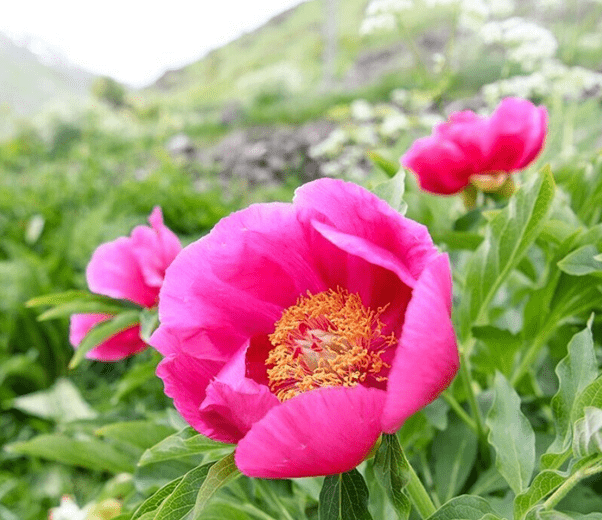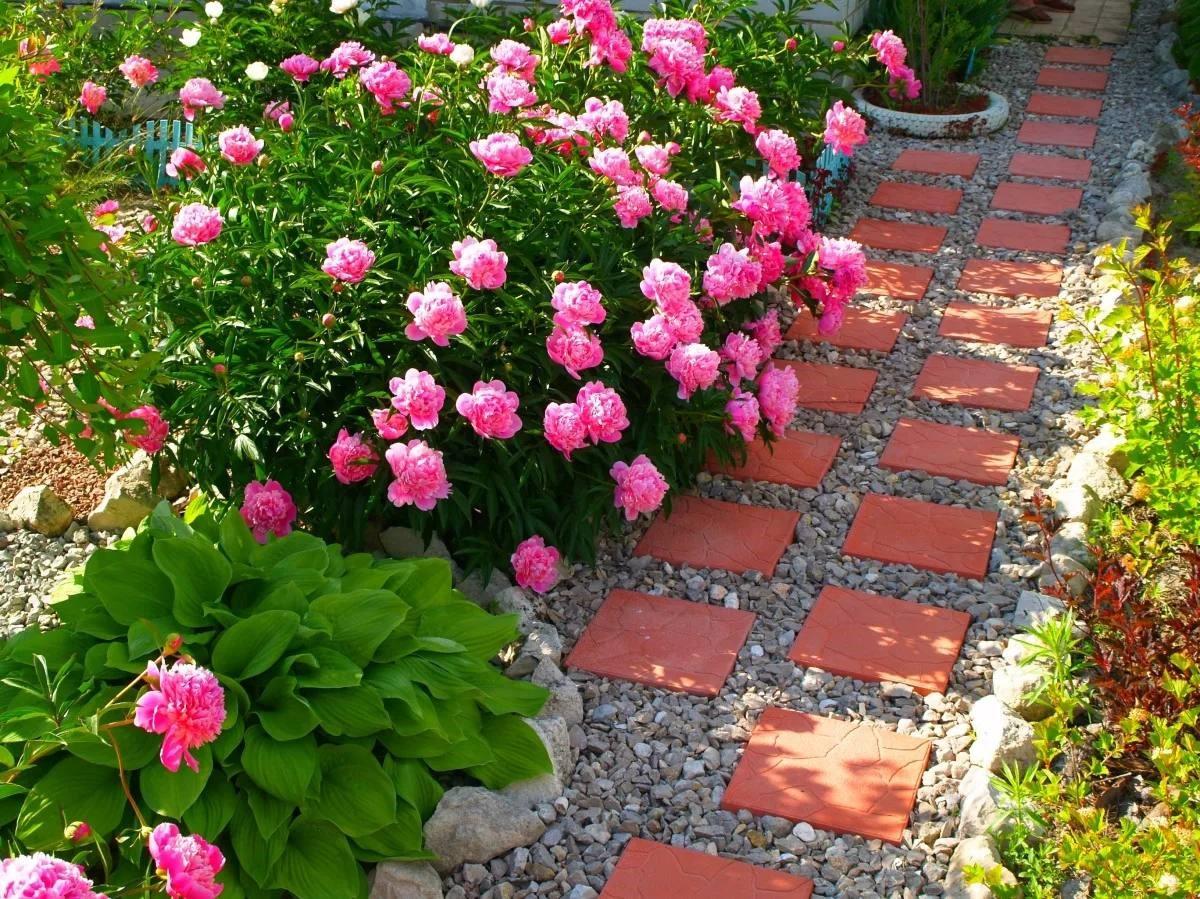Content
Peonies are popular flowers grown in the CIS countries. There are a huge variety of their types, widely used for decorating areas. The Caucasian peony is one of the rare wild-growing specimens. You can get acquainted with its features, as well as agrotechnical aspects, in this article.
Description of the Caucasian peony

The Caucasian peony variety is not very similar in appearance to its counterparts, it is more similar to a tulip
This is the “scarlet flower of the Caucasian forest.” The perennial herbaceous plant has a tap root and fleshy horizontal rhizomes. The stems are pinkish, leafy and branched. They reach a height of up to 1 meter. The foliage mass is doubly trifoliate, with oblong-oval or elliptical lobes. They are covered with a grayish waxy coating and sparse hairs. Violet-red veins are visible on the leaf plate. The top is completely bare, emerald.
The flowers are formed in large sizes, solitary, 8-10 cm in diameter. The petals are colored crimson or pinkish. They open one by one. One bush can have up to 20 flowers, which bloom in the second half of May. The fruiting period falls in the summer.The seeds have a glossy surface, black with a bluish tint.

Peony bushes bloom 3-4 years after planting
Is the Caucasian peony listed in the Red Book?
Due to the fact that the Caucasian peony variety is on the verge of extinction, it was listed in the Red Book of the Russian Federation. The species is included in the Red Data Books of the Republics of Adygea, Stavropol and Krasnodar Territories. The flower can be found in the Caucasian Biosphere and North Ossetian Nature Reserves, in the Sochi NP.
The reason for the disappearance of the mountain peony is the human factor. The decline of the species in nature was officially influenced by forest fires and deforestation. The destruction of the natural growing environment also occurs due to the economic development of areas. The number of perennial species is also declining due to the fact that people cut flowers to create bouquets for sale. Cutting has a negative effect on the condition of herbaceous bushes.

According to the law, it is prohibited to pick, dig up, or destroy the Caucasian peony
Where does it grow
The habitat of the species peony in Russia is considered to be the North Caucasus and Western Transcaucasia. The variety is widespread on the northern slope of the Greater Caucasus. Small populations are found in Krasnodar, Karachay-Cherkessia, the Republic of Adygea, Stavropol Territory and North Ossetia. An amazing herbaceous perennial can be seen on the southern slope of the Western Caucasus from Anapa to the border with Georgia.

The culture grows in Russia and Southwest Asia
Advantages and disadvantages
The Caucasian crimson peony has many advantages. Some gardeners have found negative aspects in it, but they are few.

Caucasian peony tolerates Russian winters quite well
Advantages:
- low maintenance requirements;
- high decorative qualities;
- strong immunity to diseases and insects;
- frost resistance.
Flaws:
- low availability of planting material. It is difficult to find for sale because the species is on the verge of extinction. You can find planting material from breeders or in an online store.
Features of cultivation
The species peony is cared for in the same way as other varietal brethren. There are no special features in growing this species. If desired, it can be planted on a personal plot. Problems can only occur at the stage of searching for planting material, since finding seeds is quite difficult. It is easier to collect them by hand during the fruiting period. Bushes grown in artificial conditions are different from those grown in the wild. They have a powerful root system, and the leaves and flowers are large.
The cultivation of Caucasian flowers is usually carried out by breeders of botanical gardens. They create conditions for shrubs that are close to natural. Mountain perennials planted in the countryside bloom 2-4 weeks earlier than their wild counterparts.
Caring for the Caucasian peony, like other species, is standard:
- Watering – once a week. Use settled water at room temperature.
- Loosening - the root zone should be plowed with a shovel half-length immediately after irrigation so that moisture is better absorbed.
- Preventive treatment against diseases and pests - bushes must be sprayed with chemicals 2-3 times during the growing season.
- Removing buds during flowering - in the first two years after planting, inflorescences should be removed. This is necessary so that the plant does not become depleted and the root system develops safely.
- Fertilizer - the perennial is fed 2-3 times during the growing season.It is preferable to use nitrogen-potassium compounds and special fertilizers for peonies.
- Pruning and preparation for winter - at the end of October, the stems are completely cut off, leaving stumps up to 5 cm high, the root zone is mulched with peat and spruce branches.
The wild-growing perennial can withstand frosts down to -40 degrees. It does not have to be covered on top for the winter, like other varieties. Caucasian peony grows poorly in acidic soils. The plant is best grown on fertile lands with a neutral acidity level. The place should be well lit by the sun, but partial shade is also allowed. The culture propagates by vegetative and seed methods. Seeds do not germinate well even after double stratification. Therefore, only breeders use this breeding option.
For a perennial to bloom magnificently, it requires watering from the moment of budding until the opening of the first flowers. More frequent irrigation is needed at the end of July and the first half of August. During this period, the process of laying flower buds for the next season is underway. Each peony bush will require 3 liters of water.

Special fertilizer for peonies and roses will be the best fertilizer, since it contains everything necessary for the successful growth of a perennial bush
Photo of Caucasian peony in landscape design
Caucasian perennial is widely used in territory decoration. It is best used for organizing flower beds and gardens in a natural style. The mountain flower looks attractive in the decor of small landscape compositions. The species is often used for cutting and creating bouquets. Peonies stand in water for up to 1.5 weeks. Dyes are extracted from the flowers of the perennial, and fatty oil is obtained from the seeds. The plant combines harmoniously with tall grasses and early flowering crops.
The following flora representatives are often planted next to the Caucasian peony:
- muscari;
- crocus;
- primrose;
- lungwort;
- aconite;
- tulip.
During flowering and fruiting, the peak of the plant's decorative potential is reached. Originally shaped boxes with glossy seeds open on the bushes.
You can decorate the area with Caucasian peonies, following ready-made options:
- Alpine slide. Flower beds of peonies, tulips and roses look harmonious in small summer cottages. Bright bushes will add zest to any rock garden.
- Single flower bed. A monoflower can be formed from Caucasian peony in tandem with other varieties. It is advisable that they bloom alternately so that the flowerbed does not lose its decorative effect. Plants should be planted at a distance of 1 m. Peonies should be combined with each other in color scheme. The Caucasian variety harmonizes with white, milky shades.
- Border. Caucasian bright crimson peonies will perfectly frame paths and garden paths. If you wish, you can experiment and plant flowers of different shades together.
- Rabatka. A rectangular flowerbed is usually placed against the background of a lawn, along a fence or walls of a house. You can plant mantle, salvia oak grove or scarlet geranium next to the Caucasian peonies.
- Mixborder. This is one of the classic options for decorating a dacha area. Peonies will look harmonious against the background of a green lawn. Suitable companion plants include geranium, lupine, cereals and hostas.
The Caucasian type of peony should not be planted in the company of lilies of the valley
Conclusion
The wild-growing Caucasian peony does not require special care. Mountain perennial is usually grown by breeders. Its planting material is taken from cultivated plantings. The herbaceous bush is grown in the same way as its counterparts. The mountain flower is considered universal. It will become a chic decoration of any area.













